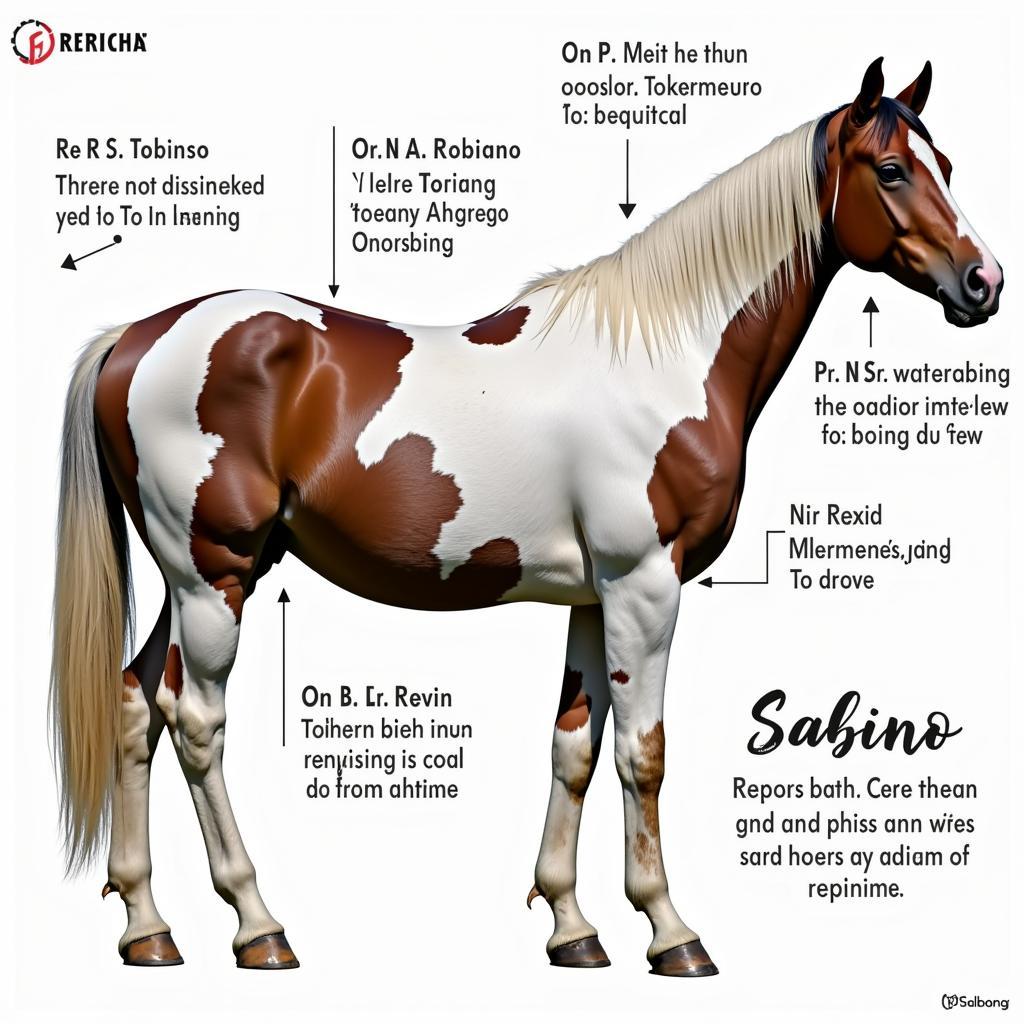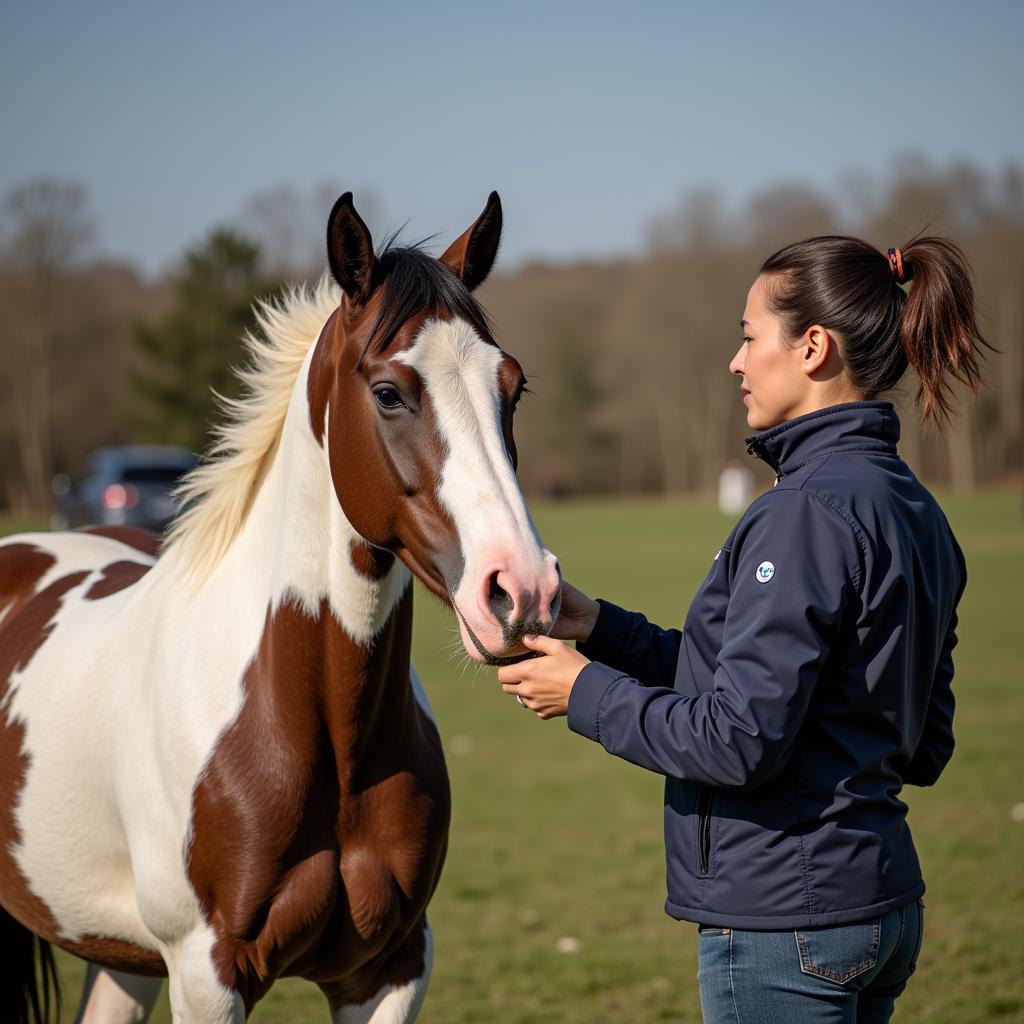Patches The Horse, a common and endearing sight in pastures and stables across the country, represents the unique beauty and individuality found in equines. Whether referring to a specific horse named Patches or the general concept of horses with patched coat patterns, this guide delves into the fascinating world of these captivating creatures, covering everything from coat genetics to care and training considerations.
Patches, like the iconic Oreo horse, are instantly recognizable by their unique coat patterns. These patterns, often a mix of white and another color, can manifest in a variety of ways, from large, irregular splotches to smaller, more defined markings. But what causes these captivating designs? Genetics plays a crucial role. Specific genes control the distribution of pigment in the horse’s coat, resulting in the diverse array of patches we see. Understanding these genetic factors can help us appreciate the complexity and beauty of each individual horse.
Decoding the Patches: Understanding Equine Coat Genetics
The genetics of coat color in horses is a complex and fascinating field. Multiple genes interact to produce the vast array of colors and patterns observed. For horses with patches, genes like the Tobiano, Overo, and Sabino genes play a significant role. Tobiano, for instance, often results in large, distinct white patches that cross the back, while Overo patterns tend to be more irregular and often leave the back a solid color. Sabino, on the other hand, often produces high white markings on the legs and face, sometimes with scattered roaning or spotting.
Just after this section, let’s insert an image showcasing the different coat patterns:
 Horse Coat Patterns: Tobiano, Overo, and Sabino
Horse Coat Patterns: Tobiano, Overo, and Sabino
Caring for Patches: Tailored Advice for Your Unique Horse
Caring for a horse with a patched coat is similar to caring for any other horse, but there are a few specific considerations. For example, white markings, especially those on the face and legs, can be more susceptible to sunburn. Using sunscreen specifically designed for horses can help protect these sensitive areas. Regular grooming is essential to maintain the health and shine of the coat, regardless of its color pattern. High-quality horse brands clothing can also offer protection from the elements.
Speaking of clothing, did you know that ladies horse riding breeches are designed for both comfort and functionality? They are a great investment for any serious rider.
Training Patches: Considerations for Your Patched Companion
Training a horse with a patched coat doesn’t differ significantly from training any other horse. The focus should always be on building a strong foundation based on trust and clear communication. Whether you’re training for pleasure riding, competitive events, or simply enjoying the companionship of your horse, consistency and patience are key. Remember, each horse, regardless of its coat pattern, is an individual with its own personality and learning style.
Are you familiar with the horse shoe pumpkin? It’s a fascinating variety!
 Training Patches the Horse: Building Trust
Training Patches the Horse: Building Trust
“Understanding a horse’s individual temperament is crucial for effective training,” says renowned equine behaviorist, Dr. Amelia Carter. “Regardless of their coat color, each horse learns and responds differently.”
Patches: Beyond the Coat
While the distinctive coat patterns of horses with patches are undoubtedly eye-catching, it’s important to remember that these markings are just one aspect of what makes each horse unique. Their personality, temperament, and abilities are far more important than their physical appearance. Whether you’re drawn to the striking contrast of a Tobiano, the intricate patterns of an Overo, or the subtle beauty of a Sabino, embrace the individuality of each patched horse. You might be surprised at how beneficial knotty horse apricot oil can be for their coat and mane. It’s a fantastic product!
Thinking of adding a new horse to your family? Check out our article about the Oreo horse.
“A patched coat is simply a beautiful expression of genetic diversity,” explains Dr. Eleanor Vance, a leading equine geneticist. “It’s the horse beneath the coat that truly matters.”
Conclusion
Patches the horse, whether a specific horse or a representation of horses with unique coat patterns, embodies the beauty and diversity within the equine world. From understanding the complex genetics behind these captivating patterns to providing tailored care and training, appreciating each horse’s individuality is paramount. So, the next time you see a horse with patches, take a moment to admire its unique beauty and remember that it’s more than just its coat that makes it special.
FAQ
- What are the most common patched coat patterns in horses?
- How can I protect my patched horse from sunburn?
- Are there any specific health concerns related to patched coat patterns?
- What are the key considerations for training a horse with a patched coat?
- How can I determine the specific genetic factors contributing to my horse’s patched coat?
- What are some good resources for learning more about equine coat genetics?
- Where can I find quality horse care products for my patched horse?
Need assistance? Contact us: Phone: 0772127271, Email: [email protected] Or visit us: QGM2+WX2, Vị Trung, Vị Thuỷ, Hậu Giang, Việt Nam. We have a 24/7 customer service team.